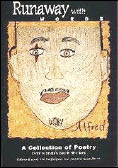Young people in foster care, juvenile justice systems or low-income neighborhoods rarely have a public voice. That is why writing programs can be so empowering. “You can confront the meaning of your experience by writing about it,” says Keith Hefner, executive director of Youth Communication, a New York nonprofit that has fostered youth writing for 27 years.
That’s one reason that out-of-school-time programs around the country are trying a variety of ways to teach youths to express themselves through writing, often helping them get published.
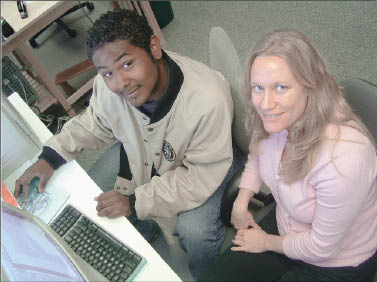 |
|
Professional Standards: Trayvione, left, gets help from L.A. Youth Editor Amanda Riddle as part of a writing program for foster youth.
Photo: L.A. Youth |
The programs do not set out to create professional writers, although that sometimes happens. Their purpose is to teach maturity and self-responsibility through self-expression. “Most of the writing kids do in our program has a reflective component,” Hefner says. “It helps kids think about who they are and who they want to become. It helps them establish an identity.”
It can also help them establish their place within a larger community. Maya Nussbaum, executive director of a small writing program for at-risk girls in New York City called Girls Write Now, describes the model as “a custom one-on-one experience, and the group experience of writing together.” Teens are paired with adult writer mentors, and share their work as a group.
“Writing is a communal enterprise,” Nussbaum says. “We try to break down the myth of the isolated writer.”
Thus the Girls Write Now participants each create a polished portfolio of their work, some of which they share with one another at workshops and other events. Many of the girls use the portfolio in their college applications.
For some programs, getting published is a major goal. “The idea of a real audience makes a huge difference to kids,” says Hefner, whose Youth Communication publishes the youth-written newspaper Represent. “It makes the writer accountable, and it motivates kids.”
That’s the case at the Foster Youth Writing Project in Los Angeles and the Urban Youth International Program in Chicago, both of which produce periodicals with youth writing. Many of the youths participate in the entire process, from brainstorming through revising, editing and publishing. That process can be challenging, especially when writing experience is not a prerequisite to join the program.
“We’ve worked with kids with very low skills to those with high-end skills,” says Amanda Riddle, an L.A. Youth editor.
Hefner says it is sometimes difficult for adults to reconcile high writing standards with working with kids who have virtually no experience. “Many have had poor education, but that doesn’t mean they’re stupid,” he says. Some programs provide writing workshops to youth in immigrant populations, which can be an even bigger obstacle.
“Often the biggest challenge is the poverty of the population,” notes Ethan Michaeli, publisher of Residents’ Journal, which began as a newspaper for the residents of Chicago’s public housing projects. He says most of the 300,000 families the newspaper serves live on annual incomes of $10,000 or less. That means the kids have no money for transportation or supplies, such as notebooks. Plus, many of them are working to help support their families.
That’s one reason that Residents’ Journal pays its youth writers, Michaeli says; it motivates them and helps compensate for their time.
Yet many writing programs for at-risk kids work on shoestring budgets that don’t allow them to pay well, if at all, or to help youths with costs. Riddle says some youths who complete their assignments with the Foster Youth Writing Project often do so because editors meet with them at their group homes or because another caring adult intervenes. For example, Riddle says that one youth writer’s social worker takes him to the L.A. Youth office each week.
Michaeli says it’s also difficult to reach kids living in low-income neighborhoods. To get to the Residents’ Journal offices, they often must contend with violent streets and drug pushers along the way.
As for the programs themselves, the major challenge is funding, because they usually can’t produce data that show longitudinal results. “Most funders want evidence of success, and that’s hard to demonstrate,” Hefner says. “Writing programs are labor-intensive, time-consuming and expensive.”
On the other hand, they produce something tangible – work completed by youths that is often published.
Michaeli says the Urban Youth International Program got started with funding from the U.S. Department of Housing and Urban Development, while Nussbaum says Girls Write Now survives largely because of its volunteer mentors. It’s not unusual to find writing programs that are run by only one full-time employee, or by a volunteer founder and a paid part-timer.
Hefner says the formula for program success is simple, although not easy: “Begin with the kids’ ideas, not the actual writing. Then work on structure. Have them address why what they want to write about is important.”
The following are four writing programs that take different approaches to youth development through the written word.
Girls Write Now
New York, N.Y.
(212) 691-6590, ext. 202
www.girlswritenow.org
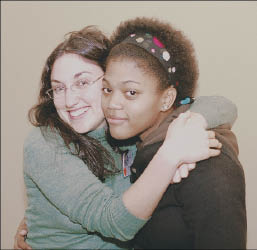 |
|
An Expressive Relationship: Mentor Allison Heiny with mentee Mary Guillermo.
Photo: Denise Simon |
The Approach: Each participant is matched with a professional woman writer who works in the girl’s field of interest, which could be in any area from poetry to public relations. The mentor helps each girl to develop a portfolio consisting of seven genres, and to edit and polish some of those pieces for an annual anthology produced by the program. The girls and mentors generally meet once a week. Girls participate in the program for up to one year, but some have worked with their mentors for longer.
The girls also participate in monthly five-hour workshops on such subjects as poetry, playwriting and editing, and share their work at three public readings.
“Girls are going through so much in their teenage years,” says Maya Nussbaum, executive director of Girls Write Now. “We wanted to create a safe, supportive environment where they could express themselves. Writing is a really effective model in which to do that.”
History and Organization: Nussbaum founded Girls Write Now 10 years ago, after earning her degree in English at Columbia University. She wanted to pass on her interest in writing to other young women. “I wasn’t that much older than the girls we serve,” says Nussbaum. “I knew how important it was to have role models.”
Youth Served: Girls Write Now sets up mentoring relationships for 35 girls each year and reaches an additional 200 through Girls Life Adventure, a writing and performance workshop held bimonthly at cultural and community organizations that are relevant to the topics the girls are exploring. For example, a recent workshop on beauty and how it is portrayed in the media took place in Times Square, while another workshop dealing with religion was held at the historic Eldridge Street Synagogue.
Both programs serve ninth- through 12th-graders, focusing on students from large, underserved high schools.
Forty-five percent of the girls in the two programs are immigrants. Most participants are recommended by parents, teachers, guidance counselors or school administrators. They must submit applications and writing samples in order to be considered.
Not all applicants get in; the program has a waiting list. Nussbaum says the agency doesn’t necessarily look for writers with the best technical skills, but for girls whose writing “demonstrates a spark.”
Staff: Nussbaum is the only full-time employee. She gets help from her board of directors and an advisory board of professionals working in fields relevant to teenage girls, such as education and nonprofits. All the mentors are volunteers and come from publications (such as Redbook and Lucky Magazine), book publishing houses, universities and nonprofit organizations.
Funding: The annual budget is $100,000. The nonprofit is funded through a variety of sources, including the city Department of Cultural Affairs, the Durst Family and the Kettering Family foundations, the Independence Community Foundation, and Barnes and Noble. Girls Write Now’s annual anthology is underwritten by the insurance company AIG.
Indicators of Success: Girls Write Now reports a 75 percent member retention rate (girls who stay for the entire program) and believes the writing portfolios, which many girls use on their college applications, help them get into college. Sixty-nine percent of the youth and adult participants stay with the program for more than one year.
Urban Youth International Journalism Program
We The People Media
Chicago, Ill.
(312) 745-2681
www.wethepeoplemedia.org
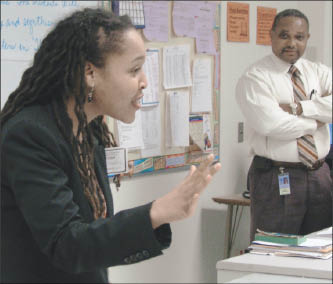 |
|
From the Pros: Associated Press reporter Karen Hawkins discusses journalism with students at Collins High School, as part of the Urban Youth International Journalism Program.
Photo: We the People |
The Approach: At-risk teens learn the basics of journalism and communications through eight one-hour workshops. Skills covered include conducting interviews, introducing yourself to new people, distinguishing between articles and commentary, and basic journalistic writing. Instructors conduct the workshops in a variety of settings, including high school English classes, after-school programs and church youth group gatherings.
Ethan Michaeli, publisher of Residents’ Journal, which started Urban Youth International, says the participants have a wide range of writing experiences, starting with none at all. He says the benefits of the program extend beyond teaching kids how to write. “It builds their self-confidence,” he says. “It gives them an understanding of how government and politics work and empowers them as citizens.”
History and Organization: The program was founded in 1998 by the staff of Residents’ Journal, a magazine by and for the residents of Chicago’s public housing projects. “The adult reporters wanted to take the mission of the newspaper to the next level,” Michaeli says. The idea was to help establish a new generation of writers for the publication, and to help expand the career opportunities and communication skills of young people living in public housing and low-income neighborhoods.
Youth Served: Each year, 75 to 100 youths participate in the Journalism 101 and Journalism 201 courses. All are from families who formerly resided in Chicago’s public housing projects, most of which have been demolished. The youths now live in segregated, low-income neighborhoods, and almost all are African-American or Latino. Teenagers are recruited for the program though youth groups, churches and schools.
Staff: We The People Media has two full-time and four part-time staffers and works with up to 100 freelance writers and others to help create and distribute Residents’ Journal, which is published six times a year. The editors of the journal work with the youth as well.
Funding: The journal’s annual budget is $300,000. The nonprofit We The People Media is funded by subscriptions and through grants from the MacArthur, Polk Brothers, Richard H. Driehaus and Landau foundations, and the Woods Fund of Chicago. Participation is free.
The Urban Youth International Journalism Program began with a grant from the U.S. Department of Housing and Urban Development’s Public Housing and Drug Elimination Program, which provided the funds to hire an instructor and conduct several educational trips in 1998 and 1999.
Indicators of Success: Michaeli says the program does not have any longitudinal studies of its success, but conducts pre- and post-evaluations to determine how much students learned in Journalism 101. He says one-third to one-half of Journalism 101 and 201 participants go on to contribute to Residents’ Journal as paid freelancers (at 15 cents a word).
L.A. Youth Foster Writing Project
Los Angeles, Calif.
(323) 938-9194
www.layouth.com
 |
|
Taking Note: Carter, a foster youth, works with L.A. Youth’s editor.
Photo: L.A. Youth |
The Approach: The project works with a small number of foster kids each year, teaching them the writing process while they work on a story for the newspaper on a subject of their choosing – generally a personal experience they have had in the foster care system. L.A. Youth Editor Amanda Riddle says most participants stay with the project about six months, meeting weekly with a staff editor for help on their stories.
Riddle says the stories tend to deal with such subjects as abuse, neglect, drug-addicted parents, depression and self-cutting. “Most of the stories are heart-breaking,” she says. “But when you’ve gone through a traumatic experience, it’s therapeutic to talk about it. They learn about who they are by reflecting on past experiences.”
Riddle says the kids are also thrilled by the letters to the editor that come in response to their stories and feel gratified that their stories have an impact on others.
Riddle believes the Writing Project is important because most foster youth living in group homes aren’t involved in extracurricular activities.
History and Organization: The project began in 2003 as part of L.A. Youth, which has been publishing articles by and about teens in Los Angeles for 20 years. The Foster Writing Project is based on Youth Communication’s Represent magazine, in New York, which is written by and for youth in foster care.
Youth Served: Participants must be in or have been in the foster care system in Los Angeles County. Each year, about 20 youths, ages 13 to 20, take part. Most are Hispanic or African-American, and most live in group homes.
Riddle says she finds project participants by placing ads in L.A. Youth, as well as through referrals from foster care agencies.
L.A. Youth pays the participants $100 for each published story. “We thought the pay was a good incentive and would give the kids an opportunity to earn money,” Riddle says.
Staff: Riddle and another of L.A. Youth’s three editors work with young people in the Foster Youth Writing project.
Funding: L.A. Youth operates on an annual budget of $650,000. The Foster Youth Writing Project is not a line item, so specific costs for it are not available. Funders have included The California Endowment, Northrop Grumman, The Los Angeles Times, the Stuart Foundation, the Dwight Stuart Youth Foundation, the Ethics & Excellence in Journalism Foundation and the Surdna Foundation.
Indicators of Success: Riddle says evidence of the Writing Project’s effectiveness is anecdotal, because the number of participants is so small. She says the youths indicate that the program has improved their self-esteem. About half of participants polish their stories enough to get them published in L.A. Youth. (Many are also republished in the Kids Quill section of Youth Today.)
According to Riddle, one young man who recently participated in the Writing Project wrote extensively about his trouble learning to control anger. He asked for a part-time job with L.A. Youth, rather than just meeting once a week with an editor to work on a story. “Now he’s in transitional living,” says Riddle. “He has his own apartment, job, and gets to school on his own.”
Runaway With Words
Tallahassee, Fla.
(850) 644-1881
www.runawaywithwords.com
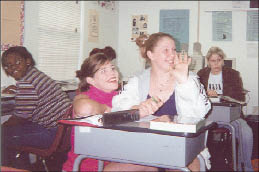 |
|
Trying her hand at poetry in a Runaway With Words workshop.
Photo: Runaway With Words |
The Approach: This 10-session poetry workshop is designed mainly for youth in shelters and after-school programs at underserved high schools. The program encourages creative expression of youths’ concerns and frustrations, including such issues as domestic abuse and drug addiction.
“It works because you’re encouraging children who have basically been silent to express their hopes and dreams,” says co-founder Joann Gardner.
Gardner says kids who have never been interested in writing “really rise to the occasion” when given the opportunity to learn to express themselves through poetry. “It’s hands-on and non-intimidating,” she says. “Poetry is a tool they can use for healing and raising self-esteem.”
The workshops, which last from 90 minutes to three hours, focus on teaching the use of imagery and music in poetry, and include sensory exercises.
History and Organization: Runaway With Words began in 1991, when Gardner, an associate professor at FSU, received a request from the Florida Network of Youth and Family Services to run poetry workshop for teens at a shelter in Panama City. She and FSU graduate Janet Hellner founded the program, which has grown to serve kids in shelters all over Florida and occasionally in other states.
Runaway With Words became a nonprofit a year-and-a-half ago.
Youth Served: The program typically serves youth ages 11 through 19 who live in shelters in Tallahassee, but also serves youth in after-school programs and abused women living in shelters. Gardner estimates that the program reaches several hundred teens each year.
Staff: The agency has six staffers, but only the head teacher is paid. The rest – typically Gardner’s graduate students – are volunteers.
Funding: The program runs on $10,000 a year and is funded primarily through grants, the main one from the Council on Culture and the Arts in Tallahassee. The funds pay the head teacher and cover supplies and transportation costs.
“We all have day jobs, and we don’t have the time to put into fundraising,” Gardner says.
Indicators of Success: The program has not had a longitudinal study of its impact. In 2004, FSU’s Department of Childhood Education, Reading and Disability Services studied 23 Runaway With Words participants at the Second Chance School in Tallahassee, finding that they increased their reading levels by an average of 1.34 years and showed a 38 percent increase in scores on Florida’s mandatory “Writes Upon Request” exam.
“The biggest measure is whether the poems are any good,” says Gardner. Each year Anhinga Press – a locally based company that specializes in poetry – publishes a book of poems by young people who have participated in the program.







